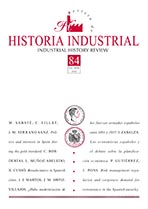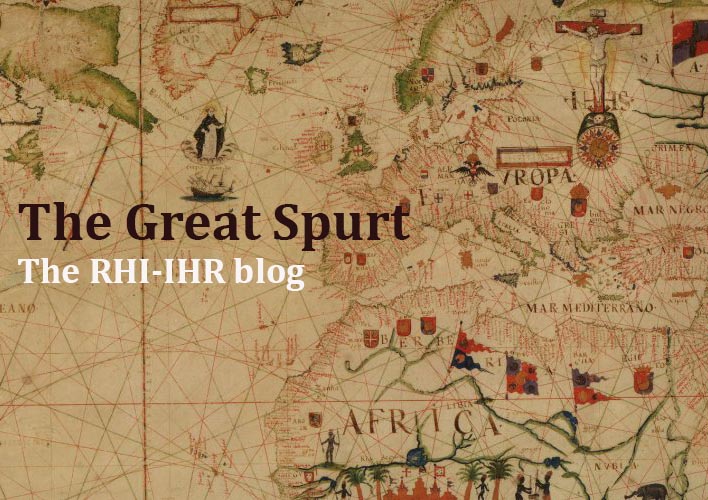Politics and interests in the classical gold standard. Spain (1876-1913)
DOI:
https://doi.org/10.1344/rhiihr.v31i84.32637Keywords:
groups of interest, gold standard, SpainAbstract
Spain never formally joined the classical gold standard, partly because its aspiration for gold convertibility did not match the financing needs of the Treasury. This paper illustrates how preferences for convertibility, that is, for fixed exchange rates, were shared by the parliamentary representatives of its manufacturing provinces because of their dependency on imported inputs (coal and cotton). However, to explain their preference for currency stability, trade policy must be considered. Without the high tariffs that the cotton industry enjoyed thorough the whole period and the steel industry from 1891 onwards, the renouncement of a procompetitive depreciating peseta might not have been so clear-cut. Thus, beyond the Spanish case, this paper supports the theoretical assumption that the input-output structure of a productive sector influences its currency stance, while reinforcing the argument that trade policy plays a key role in the understanding of currency politics.
This article is now available in open access until March 27, 2022
Downloads
References
Abad, V. 1987. La Taronja, 1781-1939. Valencia: Alfons el Magnanim.
Agirreazkuenaga, J. et al. 1993. Diccionario biográfico de los parlamentarios de Vasconia (1808-1876). Vitoria: Parlamento Vasco.
Alzola, P. 1903. Informe relativo al Proyecto de ley de mejora de los cambios. Bilbao: Impr. Casa de la Misericordia.
Anes, R. 1974a. ‘Balances Sectorizados del Banco de España (1874-1915)’. In La Banca española en la Restauración, II. Datos para una historia económica, edited by Gabriel Tortella, 141-198. Madrid: Servicio de Estudios. Banco de España.
— 1974b. ‘Una serie de la base monetaria (1874-1915). In Tortella, G. (ed.), La Banca española en la Restauración, I. Política y finanzas, edited by Gabriel Tortella, 199-209. Madird: Servicio de Estudios. Banco de España.
— 1974c. ‘El Banco de España (1874-1914). Un Banco nacional’, In Tortella, G. (ed.), La Banca española en la Restauración, I. Política y finanzas, edited by Gabriel Tortella, 107-215. Madird: Servicio de Estudios. Banco de España.
Barthe, A. 1905. Estudio crítico de la crisis monetària. Madrid: Real Academia de Ciencias Morales y Políticas.
Bordo, M.D., and H. Rockoff. 1996. ‘The Gold Standard as a “Good Housekeeping Seal of Aprovement”’, Journal of Economic History, 56: 389-428.
Bordo, M.D., and H. James. 2013. ‘The European Crisis in the Context of the History of Previous Financial Crises’. NBER Working Paper 19112.
Broz, J.L. (1997. ‘The Domestic Politics of International Monetary Order: The Gold Standard’. In Contested Social Orders and International Politics, edited by D. Skidmore, 53-91. Nashville: Vanderbilt University Press.
Broz, J.L., and J.A. Frieden. 2001. ‘The political economy of international monetary relations”, Annual Review of Political Science, 4: 317-343.
— 2006. ‘The political economy of exchange rates’. In The Oxford Handbook of Political Economy, edited by B. Wengast and D. Wittman. New York: Oxford University Press.
Carreras, A., and X. Tafunell. 2003. Historia Económica de la España Contemporánea. Barcelona: Crítica.
Castañeda, L. 2001. El Banco de España (1874-1900), la red de sucursales y los Nuevos servicios financieros. Madrid: Estudios de Historia Económica, Banco de España.
Cohen, B.J. 1993. ‘The Triad and the Unholy Trinity: Problems of International Monetary Cooperation’. In Pacific Economic Relations in the 1990s: Cooperation or Conflict?, edited by R. Higgott et al., 133-158. Allen & Unwin.
Comín, F. 2012. ‘Default, rescheduling and inflation: Public debt crises in Spain during the 19th and 20th centuries’, Revista de Historia Económica, 30: 353-390.
Comín, F., and D. Díaz. 2006. ‘Sector público administrativo y estado del bienestar’, In Estadísticas Históricas de España Siglos XIX-XX, edited by A. Carreras and X. Tafunell, vol.II, 873-964. Bilbao: Fundación BBVA.
Copelovitch M.S., and J.C.W. Pevehouse. 2013. ‘Ties that Bind? Preferential Trade Agreements and Exchange Rate Policy Choice’, International Studies Quarterly, 57: 385-399.
Díez-Minguela, A. et al. 2018. Regional Inequality in Spain, 1860-2015. Cham: Palgrave-Macmillan.
Eichengreen, B. 1995, ‘The endogeneity of exchange rate regimes’. In Understanding Interdependence, edited by P. Kenen, 3-33. Princeton: Princeton University Press.
Eichengreen, B., and P. Temin. 2010. ‘Fetters of gold and paper’, Oxford Review of Economic Policy, 26: 370-384.
Escudero, A. 1988. Minería e industrialización en Vizcaya. Barcelona: Crítica.
Estevadeordal, A. et al. 2003. ‘The rise and fall of world trade, 1870-1939’, The Quarterly Journal of Economics, 2: 359-407.
Esteves, R. et al. 2009. ‘Market Integration in the Golden Periphery. The Lisbon/London Exchange, 1854-1891’, Explorations in Economic History, 46: 324-345.
Ferguson, N., and M. Schularick. 2012. ‘The “Thin film of gold”: monetary rules and policy credibility’, European Review of Economic History, 16: 384-407.
Ferrer y Vidal, L. 1904. Informe sobre el Proyecto de ley de mejora de los cambios. Barcelona. T. Casanovas.
Frieden, J. 1991. ‘Invested interests: the politics of national economic policy in a world of global finance’, International Organizations, 45: 425-51.
— (1994). ‘Exchange Rate Politics: Contemporary lessons from American history’, Review of International Political Economy, 1: 81-98.
— .2015. Currency politics. The political economy of exchange rate policy. Princeton: Princeton University Press.
Gallego, D. 2001. ‘Sociedad, naturaleza y mercado: un análisis regional de los condicionants de la producción agraria española (1800-1936)’, Historia Agraria, 24: 11-57.
Gallego, D., and V. Pinilla. 1996. ‘Del librecambio matizado al proteccionismo selectivo: el comercio exterior de productos agrarios y alimentos en España entre 1849 y 1935’, Revista de Historia Económica, 14: 371-420 and 619-639.
Garrabou, R., and J. Sanz, eds. 1985. Historia Agraria de la España contemporánea, 2. Expansión y crisis (1850-1900). Barcelona: Crítica.
González Portilla, M. 1981. La formación de la Sociedad capitalista en el País Vasco (1876-1913). San Sebastián: Aramburu.
Grupo de Estudios de Historia Rural (GEHR). 1984. ‘Evolución de la superfície cultivada de cereales y leguminosas en España, 1886-1935’, Agricultura y Sociedad, 29: 285-325.
Hefeker, C. 1997. Interest Groups and Monetary Integration. Boulder: Westview.
Izard, M. 1979. Manufactureros, industriales y revolucionarios. Barcelona: Editorial Crítica.
Jacobson, S., and J. Moreno-Luzón. 2000. ‘The political system of the Restoration, 1875-1914: political and social elites’. In Spanish History since 1808, edited by J. Álvarez Junco and A. Shubert, 93-109. London: Arnold.
Jiménez Rodriguez, J.M. 1905. Estudio Crítico de la Crisis Monetaria. Madrid: Establecimiento tipográfico de Jaime Ratés.
Jobst, C. 2009. ‘Market leader: the Austro-Hungarian Bank and the making of foregin exchange intervention, 1896-1913’, European Review of Economic History, 13: 287-318.
López-Córdova, J.E. and C.M. Meissner. 2003. ‘Exchange-rate regimes and International trade: Evidence from the classical gold standard era’, The American Economic Review, 93: 344-352.
Martínez-Ruiz, E. and P. Nogués-Marco. 2017. ‘The political economy of exchange rate stability during the gold standard. The case of Spain 1874-1914’. Economic History Working Paper 1/2017, Geneve: Geneve University.
Mitchener, K.J., and M.D. Weidenmier. 2015. ‘Was the Classical Gold Standard Credible on the Periphery? Evidence from Currency Risk’, The Journal of Economic History, 75: 479-511.
Moreno-Luzón, J. 2007. ‘Political Clientelism, Elites, and Caciquismo in Restoration Spain (1875-1923’, European History Quarterly, 37: 417-441.
Mundell, R. 1963. ‘Capital mobility and stabilization policy under fixed and flexible exchange rates’, Canadian Journal of Economics and Political Science, 29: 475-485.
Nadal, J. 1975. El fracaso de la Revolución industrial en España, 1814-1913. Barcelona: Ariel.
Nadal, J., ed. 2003. Atlas de la Industrialización de España, 1750-2000. Barcelona: Crítica.
Navarro Reverter, J. 1912. Proyecto de ley para restablecer el nivel de los cambios sobre el extranjero. Madrid: Imprenta de la Sucesora de M. Minuesa.
Obstfeld, M., and A.M. Taylor. 2003. ‘Globalization and capital markets’. In Globalization in Historical Perspective, edited by Bordo et al. Chicago: National Bureau of Economic Research.
Officer, L. 1996. Between the Dollar- Sterling Gold points. Exchange rates, parity and market behavior. Cambridge: Cambridge University Press.
Olariaga, L. 1933. La política monetaria en España. Madrid: Librería V. Suárez.
Palomas, J. 2002. ‘El rerefons econòmic de l’activitat dels parlamentaris catalans, 1876-1885’. PhD Thesis, Bellaterra: Universitat Autònoma de Barcelona (UAB).
Prados de la Escosura, L. 1982. Comercio exterior y crecimiento económico en España, 1826-1913. Madrid: Estudios de Historia Económica 7, Banco de España.
Redish, A. 2006. ‘Recent contributions to the history of monetary and international financial systems: A review essay’, European Review of Economic History, 10: 231-248.
Sabaté, M. 1995. ‘La impronta industrial de la reforma arancelaria de 1906’, Revista de Historia Industrial, 7. 81-107.
— 1996. El proteccionismo legitimado. Madrid: Civitas.
Sabaté, M., and J.M. Serrano Sanz. 1999. ‘La política monetaria de Fernández Villaverde”, Hacienda Pública Española, Monográfico.
Sabaté, M. et al. 2006. ‘Does fiscal policy influence monetary policy? The case of Spain 1874-1935’, Explorations in Economic History, 43: 309-31.
Sabaté, M., and J.M. Serrano Sanz. 2006. ‘Estudio preliminar’. In Escritos monetarios, by R. Fernández Villaverde, 9-140. Madrid: Real Academia de Ciencias Morales y Políticas.
Sabaté, M. et al. 2015. ‘Fighting fiscal dominance. The case of Spain, 1874-1998’, European Review of Economic History, 19: 23-43.
Sabaté, M. et al. 2019. ‘Budget deficits and money creation: Exploring their relation before Bretton Woods’, Explorations in Economic History, 72: 38-56.
Sabaté, M. et al. (unpublished), ‘Economic coalitions behind the Spanish protectionist backlash (1876-1906)’.
Sardá, J. 1948. La política monetaria y las fluctuaciones de la economía española en el siglo XX. Madrid: Consejo Superior de Investigaciones Científicas.
Serrano Sanz, J.M. 1987. El viraje proteccionista en la Restauración. La política comercial española, 1875-1895. Madrid: Siglo XXI de España Editores.
— 2004. El oro en la Restauración. Madrid: Real Academia de Ciencias Morales y Políticas.
Serrano Sanz, J.M. et al. 2021. ‘Trigo y política. El proteccionismo cerealista en el Parlamento, 1886-1890’, Historia Agraria, 85. 157-184.
Solé Villalonga, G. 1967. La reforma fiscal de Villaverde, 1899-1900. Madrid: Ed. de Derecho Financiero.
Sudrià, C., and Y. Blasco Martel, eds. 2016. La pluralidad de emisión en España, 1844-1874, Bilbao: Fundación BBVA /Barcelona: Fundació Bosch i Gimpera.
Surrá, J. 1876. Demostración de la existencia del curso forzoso en España. Madrid: Imprenta de la Sociedad Tipográfica.
Tedde de Lorca, P. 1974. ‘La banca privada española durante la Restauración (1874-1914)’. In La Banca española en la Restauración, I. Política y finanzas, edited by G. Tortella, 217-455. Madrid: Servicio de Estudios. Banco de España.
Tedde de Lorca, P., and R. Anes. 1974. ‘La caída de la Casa Baring y la economía española a finales del siglo XIX’, Hacienda Pública Española, 27: 137-185.
Tortella, G. 1974. ‘Estimación del stock de oro en España (1874-1915)’. In La Banca española en la Restauración, II. Datos para una historia económica, edited by G. Tortella, 117-139. Madrid: Servicio de Estudios. Banco de España.
Downloads
Published
How to Cite
Issue
Section
License
Copyright (c) 2019 Revista de Historia Industrial – Industrial History Review

This work is licensed under a Creative Commons Attribution 4.0 International License.
We have been applying a Creative Commons Attribution license (CC-BY) since 2019, before that year we had a partial open access policy, which included open access for the first two months after publication, followed by an embargo policy for non-subscribers, as access to the last 4 published issues was restricted to journal subscribers. In contrast, early-view articles were always open access prior to publication in an assigned volume. Until 2024 the access to the last 4 published numbers was restricted to those who were subscripted to the journal.
The author assigns all rights to the publisher. Creative Commons
The author who publishes in this journal agrees to the following terms:
- The author assigns all intellectual property rights exclusively to the publisher for the entire duration of the applicable intellectual property rights. The University of Barcelona holds the copyright ownership of the contents published in the journal.
- The publisher will distribute the texts under the Creative Commons Attribution License, which allows others to share the work, provided that they acknowledge the authorship, its initial publication in this journal, and the conditions of the license.





